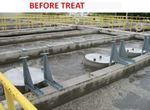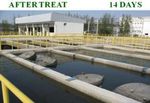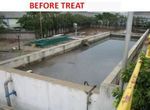Case Study Pico Wastewater Treatment AMATA City Industrial Park, Thailand
←
→
Page content transcription
If your browser does not render page correctly, please read the page content below
Case Study Pico Wastewater Treatment
AMATA City Industrial Park, Thailand
Background
Amata Nakorn Industrial Estate is located in Chonburi province on the Eastern seaboard of
Thailand. It is owned by Amata Corp. PCL covers a total area of 5,931 acres (2,400 hectares).
Through a subsidary company Amata Water Co. Ltd, Amata City provides centralised waste
water treatment services to the park’s industrial tenants with 2 WWTP’s. Industries
represented include automotive, chemical, paint, engineering, food and beverage and general
manufacturing.The plant has a design capacity of 176,573 cu ft (5,000m3) per day and has a
current average daily flow of 197,762 cu ft (5,600m3) with a capacity increase underway.
Influent to the plant is moderate strength industrial waste water
Grit Chamber Aeration Pond Sediment Tank
Challenges
Variability of influent in terms of quality parameters and range of contaminants is a challenge
in achieving consistent plant operational outcomes and discharge standards. Odor was also a
problem with some history of complaints.
Application
PICO Wastewater Treatment Product was applied under a controlled trial during the period of
5 May 2008 to 30 June 2008. Data was taken for 14 days as a baseline and PICO dosing
commenced on 20th May 2008. Measurements were taken for a total of 28 days. PICO was
mixed into solution in a 264Gal (1,000L) reservoir with continuous aeration and metered into
the plant to achieve the following dosage rates:Day 1: 4ppm Day 2: 2ppm Day 3: 1ppm Day 4-14: 0.5ppm The solution was added into the Grit Chamber at the inlet to the WWTP to provide maximum resonance time. Results Data was captured by the plant operators and entered into the daily monitoring and control sheet following normal daily procedures. Influent quality parameters of Biological Oxygen Demand (BOD5) and Chemical Oxygen Demand (COD) were taken at the Equalisation Tank directly down stream of the Grit Chamber and the dosing of PICO. Effluent was taken at the discharge point of the EATs. Average Results for each 14 day period is shown in the table below:
Discussion BOD5 Influent to the Extended Aeration Tanks (EAT’s) showed a 71% reduction in average BOD5 when PICO was applied. This is due to the rapid removal of organic waste by PICO. Mean Average Deviation (M.A.D.) showed a 69% improvement highlighting the reduced variability in influent BOD5 and the improved plant stability. This reduced BOD5 load
into the EAT’s provides the opportunity to either reduce electricity consumption due to the natural increase in Dissolved Oxygen (D.O.) levels, or it can provide an opportunity to improve the plant capacity without capital expenditure due to higher efficiency of the biological system. COD Influent to the Extended Aeration Tanks (EAT’s) showed a 60% reduction in average COD when PICO was applied as a catalyst. Mean Average Deviation (M.A.D.) showed a 81% improvement highlighting the reduced variability in influent COD and the improved plant stability. This simplifies plant operations. Again the reduced COD load into the EAT’s provides the opportunity to either reduce electricity consumption due to the natural increase in Dissolved Oxygen (D.O.) levels, or it can provide an opportunity to improve the plant capacity without capital expenditure due to higher efficiency of the biological system. SS Suspended Solids in the influent rose from an average of 0.0154 - 0.0172oz/gal (115 - 129mg/l) when PICO was added to the plant. When PICO is first added to a plant it begins to activate the accumulated sludge that has built up through the plant. As a result during the initial weeks it is common to see a rise in influent SS levels. Due to the increased plant efficiency however, effluent SS is improved 0.0044 - 0.0031oz/gal (33 - 23mg/l). As the accumulated sludge is digested, influent SS will fall and there is an overall reduction in bio-solid sludge output. MLSS Mixed Liquor Suspended Solids in the EAT’s was reduced by 34%. This is despite the increased SS in the influent as described above. Again when the accumulated sludge is digested the MLSS will drop dramatically. This would be expected over the period 2 to 8 weeks following introduction. In the 2nd week of PICO dosing, the average MLSS levels fell compared to the first week beginning to show this effect. MLVSS Mixed Liquor Volatile Suspended Solids in the EAT’s was reduced by 36%. The comments above for MLSS also apply to the MLVSS.
SV30 The Sludge Volume 30 minute settling test has shown a reduction from an average of 0.0948 - 0.0628oz/gal (710 - 470mg/l). This is due to the reduced sludge volume. Sett ability of solids is improved when PICO has been used for some time. Reductions in bio-solids output in industrial WWTP’s in excess of 90% have been experienced following continuous usage. Corresponding to this sludge volume reduction is a reduced consumption of chemicals such as polymer for coagulation and flocculation. About PICO Wastewater Treatment Product The result of over 30 years of research and development, PICO is a powerful blend of biocatalysts that breaks down complex organic molecules to help eliminate waste, reduce odors, improve soil fertility and enhance water quality, among other uses. 100% natural and non-toxic, PICO is safe for everyday use in a wide range of consumer and industrial products. It has been proven to solve problems in environmental management (including wastewater, solid waste, soil and water remediation and industrial emissions), as well as agriculture. PICO products are used extensively and available in Asia, Australia, Europe, North America and Latin America. Developed specially for the Wastewater Treatment industry, PICO accelerates the biological removal of nutrients, pathogens, suspended solids and other contaminants from wastewater.
You can also read

























































